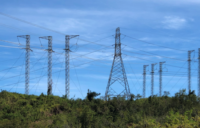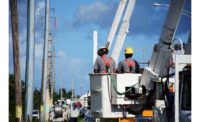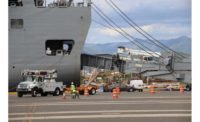Energy Viewpoint
Puerto Rico and the Consequences of Postponed Electrical Grid Upgrades
What Hurricanes Irma and Maria teach

Steven Sands sits outside his home with a flashlight and his smart phone at night, coping with the lack of electricity in the aftermath of Hurricane Maria in San Juan, Puerto Rico, Wednesday, Sept. 27, 2017. Photo: Gerald Herbert/AP
The devastation wrought by Hurricane Maria on Puerto Rico is exhibit “A” in the importance of maintaining and upgrading infrastructure despite the costs of doing so. It has driven home the point that infrastructure is costly, but its benefits are essential to life safety, the economy and human health and comfort. The storm has left almost all the island’s 3.5 million inhabitants without power. They must contend with the prospect of living without electricity for months.
Proper care and maintenance might have protected the infrastructure from damage. Maria’s 155-mph winds would have devastated almost any electric infrastructure, but years of neglect and underspending by the Puerto Rico Electric Power Authority left the system in tatters even before the storm struck. Now, in addition to restoring the infrastructure, the costs of ruined lives and livelihoods, lost income, economic decline and public-health protection must be added to the cost of restoring infrastructure that should have been better maintained. The bottom line is we can pay now or pay later.
Now, in addition to restoring the infrastructure, the costs of ruined lives and livelihoods, lost income, economic decline and public-health protection must be added to the cost of restoring infrastructure that should have been better maintained.
There has been a heightened awareness of the need for hardening since the 2004-2005 storm season, says Bill Snyder, vice president of technical consulting for Quanta Technology, which has studied and is helping to implement some hardening strategies. “I think most utilities have evaluated how to do hardening.”
Utilities initially faced some pushback from consumer groups and regulators about the cost of the hardening upgrades, but as storms, floods and tornadoes have increased, “Regulatory authorities, in our experience, are more aware and more interested in reduced outage time,” Snyder says.
Regulators and utilities are looking beyond a cost-benefit analysis that tallies only the price of replacing infrastructure to a cost-benefit analysis that also accounts for the lost wages, lost business and lost lives. “A broader economic view is becoming a more common approach in the regulatory authority for hardening,” Snyder says. Storm-hardening activities generally also improve the general reliability of the grid.
Florida now even requires its utilities to have a storm-hardening plan. This forward-thinking approach enabled Florida Power and Light to invest $3 billion in its grid, and at first blush, appears to have allowed the distribution system to withstand Hurricane Irma’s 145-mph winds. Duke Energy Florida is embarking on a similar program; New Orleans-based Entergy spends $1 billion a year on storm-hardening; and New Jersey’s Public Service Electric and Gas spent $1.2 billion hardening its system after Superstorm Sandy. Microgrids are being used in some areas to keep critical hospitals and other infrastructure operational when the rest of the grid fails.
While there has been a great deal more oversight and spending on electric infrastructure on the U.S. mainland, we still have an electric grid that is aging, old, underfunded and in many places unable to withstand storms.
A 2013 report from the U.S. Energy Dept. and the President’s Council of Economic Advisers found that between 2003 and 2012 weather-related power outages cost the U.S. economy an average of $18 billion to $33 billion each year, and in 2008, when Hurricane Ike hit, may have cost up to $75 billion. During that time, there were 679 widespread outages due to weather including blizzards, droughts, and storms. The U.S. Energy Information Administration says weather-related outages have increased significantly since 1992.
More Susceptible to Storm Damage
The report highlights two key conclusions: the aging of the grid has made the U.S. more susceptible to severe-weather outages; and events that cause these billion-dollar outages are going to become more frequent.
The American Society of Civil Engineers, in its infrastructure report card this year, gave the nation’s energy infrastructure a “D+” in part because of inadequate infrastructure upgrades and storm-hardening. “Some states have enacted storm-hardening’ policies to improve reliability during weather events, but these are typically influenced by local politics, rather than engineers’ recommendations,” according to the ASCE report.
This century, spending on storm-hardening is on the rise, but the efforts are sporadic and underfunded. As highlighted in the ASCE report, national “storm-hardening policies” are needed to improve reliability during weather events.
Without such policies or federal leadership, states that have invested little in hardening efforts may find themselves, like Puerto Rico, with a recovery bill they simply can’t afford after the next storm. Also similar to the Caribbean territory’s current dilemma, that’s simply a cost too great for the public to bear.




